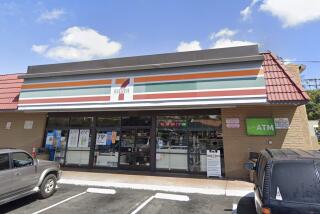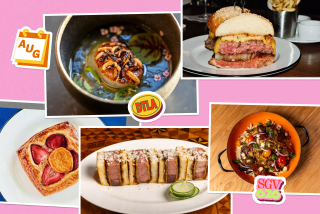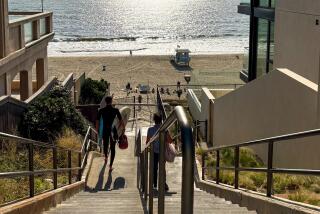Long Beach’s Rocky Road : Crime Puts a Damper on Anaheim Street’s Rich Offerings
It’s not much to look at, this treeless commercial strip of auto-body shops and drive-through hamburger joints and dark convenience stores where the canned goods may be dusty but the liquor bottles gleam like the front window at Tiffany’s.
But Anaheim Street, which spills untidily across southern Long Beach, from the truck stops in the harbor district to the upscale Los Altos residential neighborhood, plays a crucial role in the city’s commercial and cultural life.
In recent years, the street’s inelegant hodgepodge of businesses--more than 700 of them, at last count--has become the entry point for hundreds of minority entrepreneurs. Anaheim Street is where Cambodians, Mexicans and other recent arrivals take their first steps into the American free-enterprise system.
Nestled unobtrusively among El Pollo Loco, Midas Muffler and other franchise outlets are tropical produce stores, Cambodian grocery shops, pinata stores, carnicerias and a collection of restaurants offering everything from burritos and Salvadoran pupusas to pad thai and down-home barbecued ribs.
“What you have there are the pushcart vendors of the 1990s,” said City Councilman Ray Grabinski, whose district encompasses a portion of the strip.
On the single commercial thoroughfare, one can buy yucca roots, lemon grass, joss paper, Thai eggplant, old-fashioned washboards, imported jewelry, cheese for enchiladas, exotic fishing tackle, grinding stones, tortilla meal, loose corn husks, home-cooked pork rinds, gardening tools and a six-pack of Budweiser.
The mix of commerce and culture along Anaheim Street’s five miles sparks occasional reveries among merchants; they sometimes dream together over lunch about attracting the big spenders.
The street could be an international bazaar, a stopping-off point for shoppers with Visas and MasterCards, said Sandy Blankenship, director of the Cambodian Business Assn. “Why go to Los Angeles?” she said. “Anything you want to try--it’s right there on the street.”
The trouble is, most merchants concede, Anaheim Street needs a serious make-over--from cosmetic improvements to the storefronts to reductions in rampant petty crime--before the tourist buses start rolling in.
The street wrestles with a two-ton gorilla of an image problem, they say. “I get calls all the time from Cerritos and Torrance,” said Deborah Turner, owner of Doggie In The Window, a pet grooming shop where more than 100 dogs and cats are washed, primped and blow-dried every Saturday. “People say, ‘I’ve heard about your business but I’m afraid to go down there.’ ”
By most accounts, the street hit a low point in the early 1980s, when dozens of businesses failed and prostitutes and drug-dealers moved in.
Then, thousands of Cambodians, refugees from the reign of terror in their country in the late 1970s under dictator Pol Pot, began settling in the area. And members of this new community began opening their own stores.
The new Cambodian businesses--restaurants, jewelers, grocery stores and doughnut shops, usually with Cambodian writing on the front--have given Anaheim Street a shot of energy, city officials say.
There are more than 300 Cambodian-owned businesses in Long Beach, most of them along Anaheim Street, according to the social service group United Cambodian Community.
“This is an area that was surely in its death throes 10 years ago,” Grabinski said. “Now there are shopping centers where most forecasters would have said nothing good could come of it.”
But the street is still plagued by burglars and other street criminals.
The Police Department does not keep separate statistics for crimes committed on Anaheim Street, but a spokeswoman acknowledged that its South Patrol Division, which includes most of the commercial strip, is by far the department’s busiest.
After dark, dim amber-colored street lights go on, most pedestrians disappear and shop gates and shutters clatter shut.
For the few businesses that remain open, there is sometimes a siege mentality. “People come and ask for free chicken,” said Abu Taher, the manager of a Church’s Fried Chicken outlet on the street, “and when they don’t get it, they throw stones and break the windows.”
One man recently put his hand in the window where orders are taken and knocked over a $2,500 cash register, said the Bangladesh-born Taher. Two months ago, gunmen forced their way into the store at closing time, pistol-whipped employees, and escaped with $700.
Still, some merchants appear oblivious to the nighttime fears. Brite Spot, a 24-hour Mexican restaurant, stands out like a neon beacon in the dark at the corner of Anaheim and Walnut Avenue. It’s a lively place even at 1 a.m., with a steady stream of rancheras pouring from the jukebox and low-cost food, with ample ladles of beans and rice.
For owner Guadalupe Perez, the key to his consistently tranquilo restaurant is its informality. “People feel like they’re at home here,” he said. “For our regular customers, if they have no money, no problema .”
On Saturday nights on Anaheim Street, the sidewalk traffic sticks around a little longer, and the activity offers a glimpse of what some planners see as the street’s future. Mariachi trios often ply the street, traveling from one Mexican restaurant to the next. Cambodian wedding parties, with women in traditional lace and silk dresses, bustle in and out of banquet halls.
*
For at least a decade, local merchants have pushed plans to upgrade the street and to mainstream its ethnically oriented merchandise.
But the street is not a City Hall priority, residents and merchants complain. “Minority neighborhoods have never been a priority of this city,” said Councilwoman Doris Topsy-Elvord, whose family once owned a restaurant on Anaheim Street.
“It’s frustrating to see the mayor of Los Angeles fighting for (that city’s) projects, while our city does nothing,” said Harry Boerner, president of the Anaheim Street Business Assn.
That’s not quite accurate, city officials say.
Long Beach officials have declared Anaheim Street an enterprise zone, providing some employers with subsidies and tax breaks. And it has funneled small federal grants to minority businesses there. Last year, the city included Anaheim Street in a huge octopus-shaped community redevelopment area, making it eligible to use a share of property taxes for new capital projects.
But even city officials concede that observable change is probably years away. “The street just really became a redevelopment area at the start of the year,” said Fred Solomon, manager of the city’s Redevelopment Bureau. “It’s at least a year or two away from accruing funds to do anything.”
The Police Department, turning up the heat on street criminals, has put foot patrols in the area and plans to begin using bicycle patrols there as well.
Detectives from the department’s gang detail have also been assisting Asian merchants to resist extortion demands from Cambodian gangs. Because of the gangs’ intimidation tactics, the detectives’ success has been limited, said Detective Norm Sorenson.
“Some of (the business people) think it’s a lot less hassle to succumb to the demands of the gangs,” Sorenson said.
The merchants, some of whom began a “business watch” program last month to keep an eye on each other’s stores and alert police to problems, agree that the police have been responding with renewed alacrity. In the first week of the business watch there were four arrests stemming from merchants’ calls, including one drug bust, said Turner, owner of the pet-grooming shop.
Some merchants have tried to do things on their own to fix up the street.
About five years ago, said Vora Huy Khanthoul, executive director of United Cambodian Community, there were meetings about a plan to transform the street into a sort of Little Phnom Penh. The idea was to give the central part of Anaheim Street an aesthetic theme--”like Little Tokyo or Chinatown, with a McDonald’s with a pagoda roof,” Khanthoul said.
Despite the proliferation of Cambodian, Vietnamese, Thai and Chinese businesses, however, the idea of the unifying theme disappeared with the collapse of the real estate boom, community leaders say. It never got beyond the pipe-dream stage.
More recently, there was the electric trolley bus fiasco.
Late last year, after two years of planning and $11.6 million of design and engineering work, the Metropolitan Transportation Authority voted to scuttle a planned trolley system along Anaheim and 7th streets. Faced with a $126-million deficit, the MTA erased the program, which would have entailed capital costs of up to $5 million per mile.
The plan, its advocates say, would not only have helped to reduce air and noise pollution with electric buses, but it would also have given Anaheim Street a face lift, using mostly federal and state funds.
According to Boerner, Anaheim Street merchants had met numerous times with engineers and designers to discuss everything from the shape of new lamp posts and the look of new bus shelters to the species of palm trees to be installed along the trolley route.
And then the rug was pulled out.
“It would have meant the renaissance of Anaheim Street,” said Boerner, who owns an Anaheim Street electronics store that was looted during the 1992 riots following the state trial in the Rodney G. King police beating case.
Connoisseurs of Anaheim Street say that, for all of its shortcomings, it exhibits a spunky, unpretentious vigor unmatched by any other Long Beach street. There are rarely any vacant stores.
“It already is an international bazaar,” said Dixie Swift, director of Homeland, a community arts program run by the city’s Department of Parks, Recreation and Marine.
But it takes an urban adventurer like Swift to pick the gems out of the commercial sprawl.
The street has always been a low-end commercial street--”a discount center,” one store owner calls it. In the 1940s and 1950s, most of the merchants were European Jewish immigrants. By the 1970s, as blacks and Latinos replaced whites in the little bungalows and apartment buildings, the central part of Anaheim Street became a black shopping and entertainment strip, with restaurants and bars.
About half a dozen black businesses have hung on, including the Butler Barn, a liquor store where the owner, Alfred Butler, sometimes bemoans the way he ekes out a living seven days a week, envied by some of his impoverished customers but enduring hard times himself.
As many blacks have moved farther north, sales have become skimpy on Anaheim Street, Butler said.
There’s a wild and woolly end of Anaheim Street, west of Pacific Avenue. The sidewalks here sometimes seethe with panhandlers and street hustlers, and, according to residents, there is an active late-night drug market.
The merchants there are a hearty group, seeking to sell their wares to a community of impoverished new immigrants and transients. “No good at night,” said a Korean mechanic who works in the area. “A lot of people come out and sell crack. We close at 5.”
But Palestinian-born Othman Shalabi and Ziad Saad, who have run a 99-Cent store on the north side of the street for a year, recently saw entrepreneurial opportunity there.
After watching Latino homemakers trekking to a grocery store 12 blocks away, the two Palestinians last month opened La Bodega on the south side of the street. The colorful store, with a depiction of a large cornucopia with tumbling fruits and vegetables on the front, now does a booming business in Latino produce, from plantains to pineapples.
The two merchants, both of whom have become fluent in Spanish from dealing with Spanish-speaking customers, brush off the dangers of doing business on Anaheim Street.
It’s not the crooks, but the competition from small markets on the side streets, Saad said. “That’s what makes it tough,” he said.
One establishment that doesn’t worry about street criminals is the Long Beach Kick Boxing Center, which resounds with the grunts and sighs of students pummeling each other in the four-limbed Thai fighting style.
“It’s the best self-defense,” said teacher Oumry Ban, 49, a still boyish-looking Cambodian, who fought professionally in the rings of Southeast Asia for 14 years before coming to the United States in 1981.
Anaheim Street businesses are not all newcomers.
Joe Jost’s, a couple of miles farther east, has been plying draft beer and pickled eggs for 70 years.
A long room, with pool tables in the back and walls plastered with pictures of customers wearing Joe Jost T-shirts in settings from the Bahamas to Bangkok, the bar’s old-fashioned saloon ambience is a favorite with movie and commercial makers. (Kevin Costner brought Whitney Houston there in “The Bodyguard.”)
The bar’s busiest day is Christmas Eve, when former residents of the area’s single-family bungalows come home to visit, said owner Ken Buck. “We get four generations of family members in here,” says Buck, the grandson of the founder. “There are people who remember their grandfather bringing them in, and now they’re bringing their own kids in.”
Next door is another Anaheim Street institution, Fishermen’s Hardware, where anglers from as far away as Zaire and New Zealand come to buy fishing tackle. The store, with its bins of lures and stands of rods, offers the equipment to go after anything “from the smallest pan fish to the largest marlin,” said manager Don Somerville.
On the walls are Fiberglas replicas of some clients’ catches, including a 311-pound yellow-fin tuna and a 468-pound marlin.
Across the street is the Anaheim Street Ace Hardware Store, founded 42 years ago as Evans Hardware. For the past seven years, the store has been owned by Tyler Barnes, who insists that Anaheim Street is a great place to do business.
Barnes has modernized the stock, laid it out on neat pegboard stands and, establishing accounts with most of the apartment buildings in the neighborhood, multiplied sales by a factor of 10, he says. “This place is a gold mine,” he said.
Among the Cambodian merchants who have gained a foothold on the street, there’s a stubborn determination to stay. Many of them, survivors of Cambodia’s “killing fields,” have built their businesses by borrowing from friends and spending long hours at work.
One of the most ambitious Cambodian enterprises is Apsara, a spacious restaurant on Atlantic Avenue, just north of Anaheim Street.
In two years, Apsara, with its striking frieze-work sculptures reminiscent of the holy Cambodian city of Angkor Wat, has become a favorite spot for weddings and other celebrations.
More to Read
Sign up for The Wild
We’ll help you find the best places to hike, bike and run, as well as the perfect silent spots for meditation and yoga.
You may occasionally receive promotional content from the Los Angeles Times.






